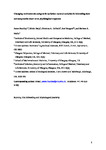Changing environments and genetic variation: natural variation in inbreeding does not compromise short-term physiological responses
| dc.contributor.author | Buckley, James | |
| dc.contributor.author | Daly, Rónán | |
| dc.contributor.author | Cobbold, Christina | |
| dc.contributor.author | Burgess, Karl | |
| dc.contributor.author | Mable, Barbara | |
| dc.date.accessioned | 2020-09-15T08:06:16Z | |
| dc.date.available | 2020-09-15T08:06:16Z | |
| dc.date.issued | 2019-11-20 | |
| dc.identifier.issn | 0962-8452 | |
| dc.identifier.issn | 1471-2954 | |
| dc.identifier.other | ARTN 20192109 | |
| dc.identifier.uri | http://hdl.handle.net/10026.1/16267 | |
| dc.description.abstract |
<jats:p>Selfing plant lineages are surprisingly widespread and successful in a broad range of environments, despite showing reduced genetic diversity, which is predicted to reduce their long-term evolutionary potential. However, appropriate short-term plastic responses to new environmental conditions might not require high levels of standing genetic variation. In this study, we tested whether mating system variation among populations, and associated changes in genetic variability, affected short-term responses to environmental challenges. We compared relative fitness and metabolome profiles of naturally outbreeding (genetically diverse) and inbreeding (genetically depauperate) populations of a perennial plant,<jats:italic>Arabidopsis lyrata</jats:italic>, under constant growth chamber conditions and an outdoor common garden environment outside its native range. We found no effect of inbreeding on survival, flowering phenology or short-term physiological responses. Specifically, naturally occurring inbreeding had no significant effects on the plasticity of metabolome profiles, using either multivariate approaches or analysis of variation in individual metabolites, with inbreeding populations showing similar physiological responses to outbreeding populations over time in both growing environments. We conclude that low genetic diversity in naturally inbred populations may not always compromise fitness or short-term physiological capacity to respond to environmental change, which could help to explain the global success of selfing mating strategies.</jats:p> | |
| dc.format.extent | 20192109-20192109 | |
| dc.format.medium | Print-Electronic | |
| dc.language | en | |
| dc.language.iso | eng | |
| dc.publisher | The Royal Society | |
| dc.subject | Arabidopsis lyrata | |
| dc.subject | inbreeding | |
| dc.subject | selfing | |
| dc.subject | genetic variation | |
| dc.subject | metabolomics | |
| dc.subject | plasticity | |
| dc.title | Changing environments and genetic variation: natural variation in inbreeding does not compromise short-term physiological responses | |
| dc.type | journal-article | |
| dc.type | Journal Article | |
| dc.type | Research Support, Non-U.S. Gov't | |
| plymouth.author-url | https://www.webofscience.com/api/gateway?GWVersion=2&SrcApp=PARTNER_APP&SrcAuth=LinksAMR&KeyUT=WOS:000504858800013&DestLinkType=FullRecord&DestApp=ALL_WOS&UsrCustomerID=11bb513d99f797142bcfeffcc58ea008 | |
| plymouth.issue | 1915 | |
| plymouth.volume | 286 | |
| plymouth.publication-status | Published | |
| plymouth.journal | Proceedings of the Royal Society B: Biological Sciences | |
| dc.identifier.doi | 10.1098/rspb.2019.2109 | |
| plymouth.organisational-group | /Plymouth | |
| plymouth.organisational-group | /Plymouth/Faculty of Science and Engineering | |
| plymouth.organisational-group | /Plymouth/Faculty of Science and Engineering/School of Biological and Marine Sciences | |
| plymouth.organisational-group | /Plymouth/REF 2021 Researchers by UoA | |
| plymouth.organisational-group | /Plymouth/REF 2021 Researchers by UoA/UoA06 Agriculture, Veterinary and Food Science | |
| plymouth.organisational-group | /Plymouth/REF 2021 Researchers by UoA/UoA06 Agriculture, Veterinary and Food Science/UoA06 Agriculture, Veterinary and Food Science MANUAL | |
| plymouth.organisational-group | /Plymouth/Users by role | |
| plymouth.organisational-group | /Plymouth/Users by role/Academics | |
| dc.publisher.place | England | |
| dc.identifier.eissn | 1471-2954 | |
| dc.rights.embargoperiod | Not known | |
| rioxxterms.versionofrecord | 10.1098/rspb.2019.2109 | |
| rioxxterms.licenseref.uri | http://www.rioxx.net/licenses/all-rights-reserved | |
| rioxxterms.type | Journal Article/Review |


